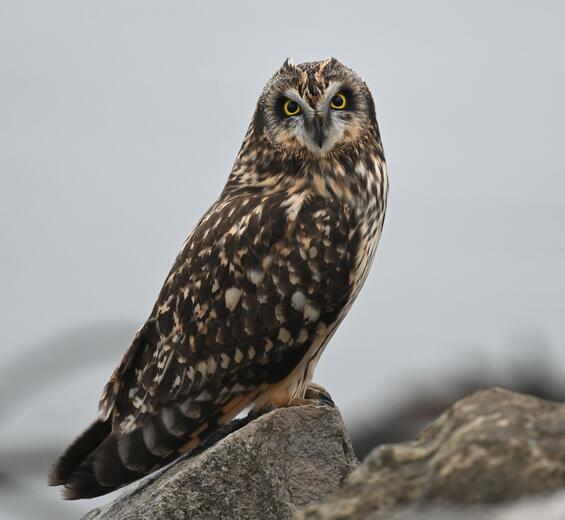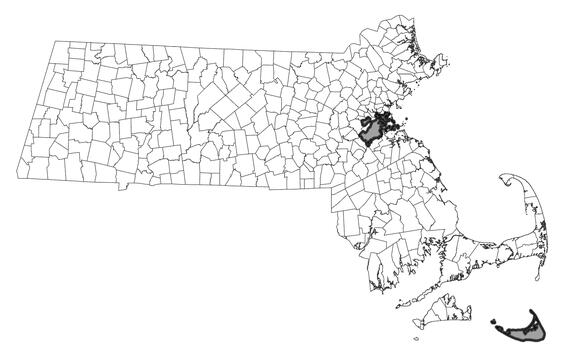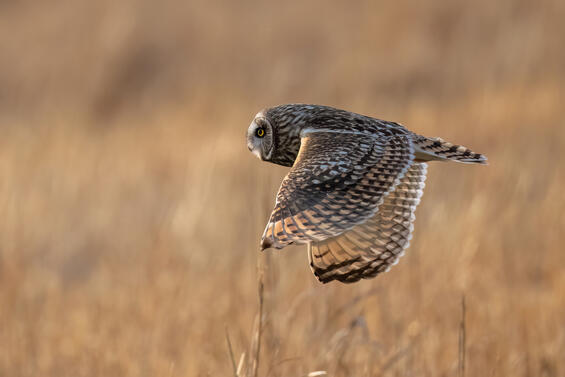- Scientific name: Asio flammeus
- Species of Greatest Conservation Need (MA State Wildlife Action Plan)
- Endangered (MA Endangered Species Act)
Description

Short-eared owl
The short-eared owl is a crow-sized bird, approximately 33-43 cm (13-17 in) long, with a wingspan of 76-91 cm (38 - 44 in). Its plumage is buffy colored, with a predominantly brownish back and a lighter head and underside with long streaks of brown. The short-eared owl has a white facial disk, with a black patch surrounding each yellow eye. The wings and tail are long and rounded (but the wings are longer than the tail). The undersurface of each wing is marked with a dark band near the bend of the wing and on the wingtip as well. The short-eared owl has very small ear tufts which are usually very difficult to observe. The legs are feathered to the feet. Females are generally larger than the males, and darker in coloration.
The only other large raptors occupying the same habitat as the short-eared owl in Massachusetts are the northern harrier and barn owl. The northern harrier is a hawk, bluish-gray (brown for females and juveniles) in coloration, with a bright white rump. The barn owl has a heart-shaped face and dark eyes; it has a buffy to brown back and a white underside. The short-eared owl is the only owl in Massachusetts which nests and roosts on the ground, hovers in flight, and frequently hunts during the day.
Life cycle and behavior
In Massachusetts, short-eared owls begin territory establishment and courting behavior in March. Courtship displays consist of breathtaking flights in which the male owl climbs to an altitude of 31 m (100 ft) or more, flying in tight circles, and utters a soft call which is repeated 13 to 16 times. It then plummets towards the ground while clapping its wings together under its belly. If the male is successful in attracting a mate, he will start a long dive earthward and rock from side to side with his wings in a “V” pattern, closely pursued head-to-tail by the female. Copulation then occurs on the ground.
The nest is constructed by the female out of dried grasses and some downy feathers. In late April, 4-10 eggs are laid over a period of several days. They are incubated by the female for 20-30 days, while her mate provides her with food. The eggs usually hatch over a period of several days in May or early June. The hatchlings leave the nest after 14 to 17 days and explore the general area on foot for the next two weeks, after which they begin their first flights. This dispersal of the hatchlings from the nest may be a defense against predators, since the nest is in such an open area. The hatchlings are fed by the parents until they learn how to fly, at which point the young return to the nest and roost together with their parents during the day.
Although short-eared owls have had a long history of nesting in Massachusetts, their numbers declined for years, and no nesting has been documented in recent years. The last known nesting occurred on Tuckernuck Island in 2010, and it is uncertain if they have attempted nesting in the state since then. Short-eared owls from more northerly breeding populations arrive in Massachusetts in late fall and can be found in small numbers throughout the winter in suitable habitat across the state.
Short-eared owls frequently forage in the early morning and late afternoon. When hunting, the short-eared owl alternately flaps and glides, from 0.3-3 m (1-10 ft) above the ground, and often hovers momentarily before either pouncing on its prey or continuing onward. It uses its keen sense of hearing to detect and locate prey. Although meadow voles constitute over 90 percent of the short- eared owl's diet, they are also known to eat insects, small birds, and other species of small mammals.
Population status
The short-eared owl is listed as an endangered species under the Massachusetts Endangered Species Act. Although no known nesting pairs remain, there is a small population of wintering birds, and it is possible birds will nest in future years. Other northeastern states where these owls have nested in recent years include New York, Pennsylvania, and Vermont. Today, any nesting by short-eared owls in the Northeast is rare, and they may be extirpated as a breeder from the region.
Distribution and abundance
Short-eared owls are widely distributed across the world; they can be found in Europe, Asia, North America, and scattered regions of South America. In North America, they have nested from New England west to California, north to Alaska, and south to southeastern Pennsylvania. Although they may now be extirpated from Massachusetts as a nesting bird, breeding pairs were previously found in the counties of Barnstable, Dukes, and Nantucket.

Distribution in Massachusetts. 1999-2024. Based on records in the Natural Heritage Database.
Habitat
Short-eared owls in Massachusetts reside in large, undeveloped expanses of coastal sandplain grassland and maritime heathland, habitats that are now quite rare. The vegetation of these habitats is comprised of clumped patches of shrubs (bayberry, huckleberry, blueberry, wild rose, dewberry, pitch pine and scrub oak) mixed with herbaceous vegetation consisting of sedges, forbs, and grasses (goldenrod, beachgrass, wild indigo, little bluestem). Short-eared owls nests on the ground, usually near or within herbaceous vegetation or low shrubs under 0.5 m (1.6 ft) in height. The territory of a single breeding pair may encompass over 100 acres.
Healthy habitats are vital for supporting native wildlife and plants. Explore habitats and learn about conservation and restoration in Massachusetts.
Threats
The greatest threat to the short- eared owl is habitat loss and degradation. The large, open, undisturbed areas where the short-eared owls breed are under enormous pressure for construction and development. Other threats include exposure to contaminants (e.g., pesticides, rodenticides) and disturbance around nest and roost sites. Nest predation by skunks is thought to have contributed to their decline in Massachusetts.
Rodenticides (e.g., Second Generation Anticoagulant Rodenticides - SGARs) move up food chains and pose a threat to raptors when they consume prey that have ingested these chemicals. As a result, SGARs have been found in a high percentage of raptors that have been tested for them in Massachusetts, and it is well documented that they can kill individual raptors. However, their population-level impacts on raptors remain largely unknown.

Conservation
To support the conservation of this species it is important to maintain large tracts of suitable habitat for both the owls and their prey in areas where they historically nested and over-wintered. Limiting human disturbance at roosting or nesting sites will promote survival of individuals.
Conduct research to better understand the impacts of highly toxic rodenticides (e.g., SGARs) to raptor populations. Promote an integrated pest management approach that emphasizes the use of alternative pest control measures whenever possible to reduce negative impacts to wildlife. Coordinate with other state agencies to improve tracking and reporting of rodenticides found in wildlife and develop outreach materials for the public.
References
Melvin, S.M., D.G. Smith, D.V. Holt, and G.R. Tate. 1989. Small owls, p. 88-98 in Proc. northeast raptor management symposium and workshop. Natl. Wild. Fed., Washington, D.C.
Palmer, R. S. 1962. Handbook of North American Birds. Yale University Press, New Haven & London.
Tate, G.R. 1992. Short-eared owl, Asio flammeus Pages 171-189 in
K.J. Schneider and D.M. Pence, eds. Migratory Nongame Birds of Management Concern in the Northeast. U.S. Dept. Inter., Fish & Wildl. Serv., Newton Corner, MA.
Terres, J. K. 1991. The Audubon Society Encyclopedia of North
American Birds. New York: Wing Books.
Wiggins, D. A., D. W. Holt, and S. M. Leasure (2020). Short-eared Owl (Asio flammeus), version 1.0. In Birds of the World (S. M. Billerman, Editor). Cornell Lab of Ornithology, Ithaca, NY, USA. https://doi.org/10.2173/bow.sheowl.01
Contact
| Date published: | April 3, 2025 |
|---|